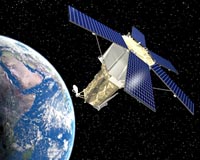 |
Washington DC (SPX) Sep 03, 2010 Operation IceBridge - a NASA airborne mission to observe changes in Earth's rapidly changing polar land ice and sea ice - is soon to embark on its fourth field season in October. The mission is now paralleled by a campaign to bring data to researchers as quickly as possible and to accelerate the analysis of those changes and how they may affect people and climate systems. "Anyone can access the wealth of IceBridge data online, and do so free of charge and without a formal request," said Michael Studinger, IceBridge project scientist at NASA's Goddard Space Flight Center in Greenbelt, Md. "It's critical for data to be free and accessible so scientists can conduct timely studies of ice dynamics and a changing climate." In 2009, mission scientists and crew flew 41 flights and collected data over about 143,000 miles - equivalent to 5.7 trips around the Earth. NASA and its designated archive for IceBridge data, the National Snow and Ice Data Center (NSIDC) at the University of Colorado at Boulder, have teamed to move that data from the aircraft and instruments to researchers' computers. In the Arctic, they used laser altimeters to collect surface elevation information for ice sheets and sea ice previously observed by NASA's Ice, Cloud, and Land Elevation Satellite (ICESat). Radar turned up measurements of snow depth on sea ice during a cross-Arctic flight. In the Antarctic, researchers made a detailed survey of the Pine Island, Thwaites, Smith, Kohler and Crane glaciers, while another instrument peeked at the detailed topography under Pine Island's floating ice tongue. They collected the first airborne data for sea ice in the Weddell and Bellingshausen Seas. To date, NSIDC has published 12 datasets from the IceBridge Greenland and Antarctica campaigns in 2009. These datasets spanned 10 instruments, including lidars, radars, sounders, gravimeters, mappers, and cameras, as well as atmospheric measurements and aircraft positioning data. "It's exciting to have such a diversity of data, preserving it for the future and making it available in ways that will encourage new discoveries," said Marilyn Kaminski, NSIDC's project manager for IceBridge. "There's so much potential that can be tapped." NASA flew its 2010 IceBridge Greenland campaign from March through May; data will be available at NSIDC in Fall 2010. NSIDC will publish data from subsequent campaigns within six to eight weeks of receipt from the data providers. This rapid turnaround will enable researchers to use these important data to monitor receding glaciers, the melting Greenland ice sheet, crumbling ice shelves on the Antarctic Peninsula, and the thinning of old, thick Arctic sea ice that has been the mainstay of the sea ice cover. Data from campaigns flown prior to the inception of IceBridge will also be archived at NSIDC. These include data from the Airborne Topographic Mapper (ATM) instrument; mountain glacier data from the University of Alaska Fairbanks; and deep radar bedmap data from University of Kansas radar instruments. Combined with NSIDC's existing complete archive of data from the Geoscience Laser Altimeter System (GLAS) instrument aboard ICESat, researchers will be able to access a rich repository of complementary measurements. IceBridge, a six-year NASA mission, is the largest airborne survey of Earth's polar ice ever flown. It will yield an unprecedented three-dimensional view of Arctic and Antarctic ice sheets, ice shelves and sea ice. These flights will provide a yearly, multi-instrument look at the behavior of the rapidly changing features of the Greenland and Antarctic ice. Data collected during IceBridge will help scientists bridge the gap in polar observations between NASA's ICESat - in orbit since 2003 - and ICESat-2, planned for late 2015. ICESat stopped collecting science data in 2009, making IceBridge critical for ensuring a continuous series of observations.
Share This Article With Planet Earth
Related Links IceBridge Mission Earth Observation News - Suppiliers, Technology and Application
 LockMart Advancing on Next-Gen Commercial Remote Sensing System For GeoEye
LockMart Advancing on Next-Gen Commercial Remote Sensing System For GeoEyeSunnyvale CA (SPX) Sep 02, 2010 The Lockheed Martin team developing GeoEye's next-generation, high-resolution commercial Earth-imaging satellite system known as GeoEye-2, has successfully completed on-schedule a System Requirements Review (SRR), an important program milestone that precedes the Preliminary Design Review. With launch scheduled to support start of operations in 2013, Lockheed Martin is developing GeoEye-2 u ... read more |
|
| The content herein, unless otherwise known to be public domain, are Copyright 1995-2010 - SpaceDaily. AFP and UPI Wire Stories are copyright Agence France-Presse and United Press International. ESA Portal Reports are copyright European Space Agency. All NASA sourced material is public domain. Additional copyrights may apply in whole or part to other bona fide parties. Advertising does not imply endorsement,agreement or approval of any opinions, statements or information provided by SpaceDaily on any Web page published or hosted by SpaceDaily. Privacy Statement |